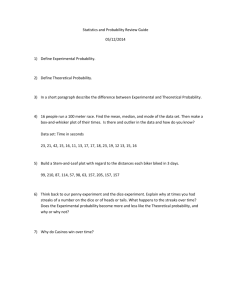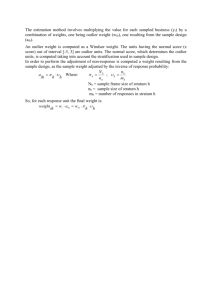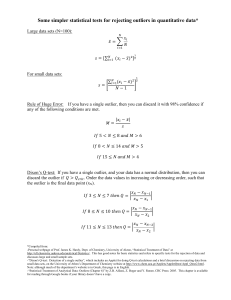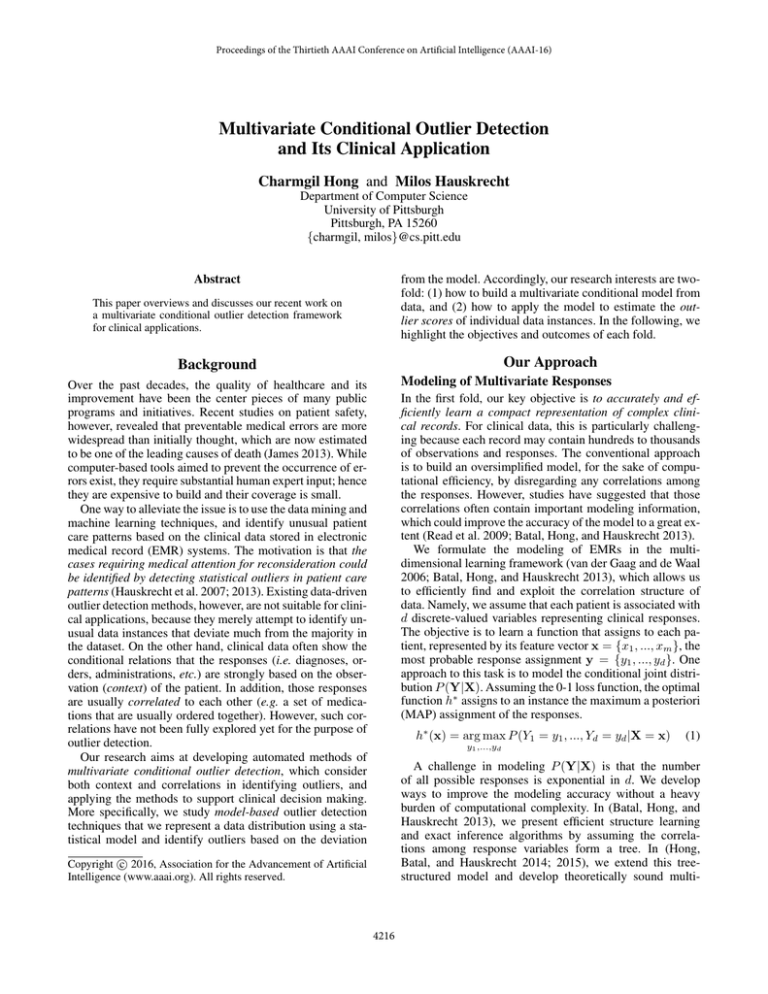
Proceedings of the Thirtieth AAAI Conference on Artificial Intelligence (AAAI-16)
Multivariate Conditional Outlier Detection
and Its Clinical Application
Charmgil Hong and Milos Hauskrecht
Department of Computer Science
University of Pittsburgh
Pittsburgh, PA 15260
{charmgil, milos}@cs.pitt.edu
from the model. Accordingly, our research interests are twofold: (1) how to build a multivariate conditional model from
data, and (2) how to apply the model to estimate the outlier scores of individual data instances. In the following, we
highlight the objectives and outcomes of each fold.
Abstract
This paper overviews and discusses our recent work on
a multivariate conditional outlier detection framework
for clinical applications.
Our Approach
Background
Modeling of Multivariate Responses
Over the past decades, the quality of healthcare and its
improvement have been the center pieces of many public
programs and initiatives. Recent studies on patient safety,
however, revealed that preventable medical errors are more
widespread than initially thought, which are now estimated
to be one of the leading causes of death (James 2013). While
computer-based tools aimed to prevent the occurrence of errors exist, they require substantial human expert input; hence
they are expensive to build and their coverage is small.
One way to alleviate the issue is to use the data mining and
machine learning techniques, and identify unusual patient
care patterns based on the clinical data stored in electronic
medical record (EMR) systems. The motivation is that the
cases requiring medical attention for reconsideration could
be identified by detecting statistical outliers in patient care
patterns (Hauskrecht et al. 2007; 2013). Existing data-driven
outlier detection methods, however, are not suitable for clinical applications, because they merely attempt to identify unusual data instances that deviate much from the majority in
the dataset. On the other hand, clinical data often show the
conditional relations that the responses (i.e. diagnoses, orders, administrations, etc.) are strongly based on the observation (context) of the patient. In addition, those responses
are usually correlated to each other (e.g. a set of medications that are usually ordered together). However, such correlations have not been fully explored yet for the purpose of
outlier detection.
Our research aims at developing automated methods of
multivariate conditional outlier detection, which consider
both context and correlations in identifying outliers, and
applying the methods to support clinical decision making.
More specifically, we study model-based outlier detection
techniques that we represent a data distribution using a statistical model and identify outliers based on the deviation
In the first fold, our key objective is to accurately and efficiently learn a compact representation of complex clinical records. For clinical data, this is particularly challenging because each record may contain hundreds to thousands
of observations and responses. The conventional approach
is to build an oversimplified model, for the sake of computational efficiency, by disregarding any correlations among
the responses. However, studies have suggested that those
correlations often contain important modeling information,
which could improve the accuracy of the model to a great extent (Read et al. 2009; Batal, Hong, and Hauskrecht 2013).
We formulate the modeling of EMRs in the multidimensional learning framework (van der Gaag and de Waal
2006; Batal, Hong, and Hauskrecht 2013), which allows us
to efficiently find and exploit the correlation structure of
data. Namely, we assume that each patient is associated with
d discrete-valued variables representing clinical responses.
The objective is to learn a function that assigns to each patient, represented by its feature vector x = {x1 , ..., xm }, the
most probable response assignment y = {y1 , ..., yd }. One
approach to this task is to model the conditional joint distribution P (Y|X). Assuming the 0-1 loss function, the optimal
function h∗ assigns to an instance the maximum a posteriori
(MAP) assignment of the responses.
h∗ (x) = arg max P (Y1 = y1 , ..., Yd = yd |X = x)
(1)
y1 ,...,yd
A challenge in modeling P (Y|X) is that the number
of all possible responses is exponential in d. We develop
ways to improve the modeling accuracy without a heavy
burden of computational complexity. In (Batal, Hong, and
Hauskrecht 2013), we present efficient structure learning
and exact inference algorithms by assuming the correlations among response variables form a tree. In (Hong,
Batal, and Hauskrecht 2014; 2015), we extend this treestructured model and develop theoretically sound multi-
c 2016, Association for the Advancement of Artificial
Copyright Intelligence (www.aaai.org). All rights reserved.
4216
dimensional ensemble frameworks. Compared to existing
multi-dimensional ensemble approaches (Read et al. 2009),
our methods produce more accurate and consistent results.
Detection of Outliers in Clinical Responses
Our interest in the second fold lies in measuring the degree
of outlier for the clinical data, based on the model obtained
from the first fold. An important advantage of our multidimensional models is that they give a well-defined estimate of the posterior response probabilities. That is, using
the decomposable structure of the multi-dimensional models (Read et al. 2009; Batal, Hong, and Hauskrecht 2013),
we can easily estimate not only the posterior joint P (y|x)
but also the posterior of individual responses P (yi |x) : i =
1, ..., d for any (x, y) pair. This is an extremely useful property in many clinical applications, such as diagnosing diseases and allergic drug reactions. We leverage this advantage
for solving the clinical outlier detection problem.
In (Hong and Hauskrecht 2015), we formalize the transformation of data from their original space to the ddimensional conditional probability space of P (yi |x), and
define the methods to estimate the outlier score for each data
instance in the new space. Compared to the existing multivariate outlier detection methods, our approach produces
more robust results and is able to identify outliers when they
are either sparse (manifested in one or only few dimensions)
or dense (affecting multiple dimensions).
Figure 1: Performance comparison in AUCPR.
sion support, but also enable a more comprehensive analysis
of complex clinical data and their underlying structures.
Acknowledgments
This work was supported by grant R01GM088224 from the
NIH. Its content is solely the responsibility of the authors
and does not necessarily represent the official views of the
NIH.
References
Amer, M.; Goldstein, M.; and Abdennadher, S. 2013. Enhancing
one-class support vector machines for unsupervised anomaly detection. In Proceedings of the ACM SIGKDD Workshop on Outlier
Detection and Description.
Batal, I.; Hong, C.; and Hauskrecht, M. 2013. An efficient probabilistic framework for multi-dimensional classification. In Proceedings of the 22nd ACM International Conference on Information and Knowledge Management.
Breunig, M. M.; Kriegel, H.-P.; Ng, R. T.; and Sander, J. 2000. Lof:
identifying density-based local outliers. In ACM sigmod record,
volume 29, 93–104. ACM.
Hauskrecht, M.; Valko, M.; Kveton, B.; Visweswaran, S.; and
Cooper, G. F. 2007. Evidence-based anomaly detection in clinical domains. In AMIA Annual Symposium Proceedings, 319-323.
Hauskrecht, M.; Batal, I.; Valko, M.; Visweswaran, S.; Cooper,
G. F.; and Clermont, G. 2013. Outlier detection for patient monitoring and alerting. Journal of Biomedical Informatics 46(1):47–55.
Hong, C., and Hauskrecht, M. 2015. Conditional outlier detection
in multivariate responses. In (pending).
Hong, C.; Batal, I.; and Hauskrecht, M. 2014. A mixtures-of-trees
framework for multi-label classification. In Proceedings of the
23nd ACM International Conference on Information and Knowledge Management, CIKM ’14. ACM.
Hong, C.; Batal, I.; and Hauskrecht, M. 2015. A generalized mixture framework for multi-label classification. In Proceedings of the
2015 SIAM International Conference on Data Mining. SIAM.
James, J. T. 2013. A new, evidence-based estimate of patient harms
associated with hospital care. Journal of patient safety 9(3):122–
128.
Pestian, J. P.; Brew, C.; Matykiewicz, P.; Hovermale, D. J.; Johnson, N.; Cohen, K. B.; and Duch, W. 2007. A shared task involving
multi-label classification of clinical free text. In Proceedings of the
Workshop on BioNLP 2007, 97–104.
Read, J.; Pfahringer, B.; Holmes, G.; and Frank, E. 2009. Classifier chains for multi-label classification. In Proceedings of the
European Conference on Machine Learning and Knowledge Discovery in Databases. Springer-Verlag.
van der Gaag, L. C., and de Waal, P. R. 2006. Multi-dimensional
bayesian network classifiers. In Probabilistic Graphical Models.
Evaluation and Discussion
We present experimental results on a clinical dataset obtained from Cincinnati Children’s Hospital Medical Center
(Pestian et al. 2007). The dataset contains 978 instances;
each consists of 1,449 features (x) extracted from clinical
progress notes and 45 binary response variables (y) representing the diseases diagnosed. We compare our Multivariate Conditional Outlier DEtection method (MCODE) (Hong
and Hauskrecht 2015) with two state-of-the-art multivariate
outlier detection methods: Local Outlier Factor (LOF) (Breunig et al. 2000) and One-class SVM (OS) (Amer, Goldstein,
and Abdennadher 2013). We performed 10-fold cross validation; on each round, we perturbed 0.5% of the data by
randomly flipping 1 to 5 response variables (hence, the outliers represent misdiagnoses), and evaluated how the methods identify the outliers. Figure 1 shows the results in terms
of the area under the precision-recall curve (AUCPR). We
can verify that our proposed approach consistently outperforms the existing multivariate outlier detection methods.
To conclude, we summarized our research on multivariate
conditional outlier detection in the context of clinical application. We described the problems and objectives of the
research, and highlighted our model-based outlier detection
approach. The wide deployment of the EMR systems and the
growing availability of large clinical datasets open up new
opportunities for understanding the dynamics of diseases,
patient conditions, and efficacy of various treatments. Accordingly, we believe the findings from our research will not
only contribute to the quality of healthcare by boosting the
utilization of EMRs and providing advanced clinical deci-
4217

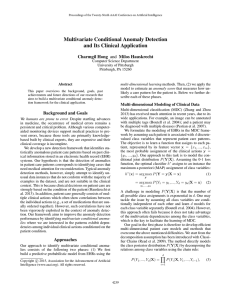
![[#GEOD-114] Triaxus univariate spatial outlier detection](http://s3.studylib.net/store/data/007657280_2-99dcc0097f6cacf303cbcdee7f6efdd2-300x300.png)


